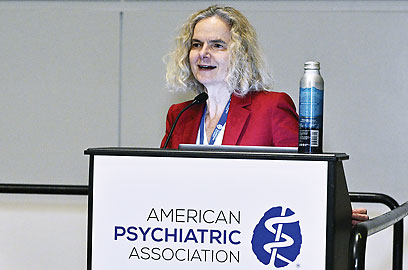The COVID-19 pandemic made many hidden truths more abundantly clear, National Institute on Drug Abuse (NIDA) Director Nora Volkow, M.D., said during a presentation at APA’s Annual Meeting in May. Among them was the power of social determinants of health—as racial and ethnic minorities, those with less income, and people with psychiatric illness bore the brunt of negative health outcomes.
Social determinants of health are also strong risk factors for substance use disorders, Volkow continued.
She noted that brain imaging data indicate that the environment plays a stronger role than genetics in guiding brain development between the ages of 5 and 8 years. In households with dysfunction, stress, and/or financial difficulties, children tend to receive more negative environmental stimulation and less positive stimulation.
Making use of new imaging data from over 7,500 9- and 10-year-old children enrolled in NIDA’s
Adolescent Brain and Cognitive Development (ABCD) Study, Volkow together with Dardo Tomasi, Ph.D., a staff scientist at the National Institute on Alcohol Abuse and Alcoholism, evaluated the relationship between family income and brain structure. Their analysis revealed that children from higher-income families appeared to have
larger and thicker frontal cortices as well as higher cognitive test scores compared with children from lower-income families.
Another brain imaging study of babies born during the COVID-19 pandemic uncovered a similar pattern: Greater levels of maternal stress and anxiety were associated with
worse connectivity between the amygdala and frontal cortex in the infants. Lower social support was a significant predictor of clinically elevated prenatal maternal distress, the study found.
Such early changes in brain structure may increase the risk of later problems with substance use, Volkow noted, as data show that people who are more sensitive to negative conditioning (for example, learning quickly not to touch a hot stove after getting burned) and/or have blunted reward conditioning are at higher risk of addiction.
Showing a correlation is one thing, but is there evidence that correlation can be changed?
Well, yes, Volkow noted. She pointed to
one controlled intervention in which 1,000 low-income mothers from several U.S. cities were randomly allocated either a $333 or $20 monthly stipend after the birth of their child. About 400 of the babies were selected for EEG scans at one year of age, and the EEG data found that babies of mothers with the high-cash stipend had more robust and active brain activity than the babies of mothers who received the low-cash stipend.
“This simple monetary intervention probably reduced the mother’s stress [related to] how she would support her child and maybe let them spend more time together,” Volkow said. There was a clear positive neurodevelopmental outcome.
Volkow acknowledged that the United States may not have the resources right now to implement some of these early-life interventions on a large scale, but building up the infrastructure is one of NIDA’s priorities. Just attenuating the impact of poverty can boost childhood development and prevent susceptibility to substance use down the road, she said. ■

